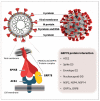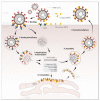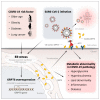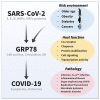GRP78, a Novel Host Factor for SARS-CoV-2: The Emerging Roles in COVID-19 Related to Metabolic Risk Factors
- PMID: 36009544
- PMCID: PMC9406123
- DOI: 10.3390/biomedicines10081995
GRP78, a Novel Host Factor for SARS-CoV-2: The Emerging Roles in COVID-19 Related to Metabolic Risk Factors
Abstract
The outbreak of coronavirus disease 19 (COVID-19), caused by the infection of severe acute respiratory syndrome coronavirus 2 (SARS-CoV-2), has resulted in an unprecedented amount of infection cases and deaths, leading to the global health crisis. Despite many research efforts, our understanding of COVID-19 remains elusive. Recent studies have suggested that cell surface glucose-regulated protein 78 (GRP78) acts as a host co-receptor for SARS-CoV-2 infection and is related to COVID-19 risks, such as older age, obesity, and diabetes. Given its significance in a wide range of biological processes, such as protein homeostasis and cellular signaling, GRP78 might also play an important role in various stages of the viral life cycle and pathology of SARS-CoV-2. In this perspective, we explore the emerging and potential roles of GRP78 in SARS-CoV-2 infection. Additionally, we discuss the association with COVID-19 risks and symptoms. We hope this review article will be helpful to understand COVID-19 pathology and promote attention and study of GRP78 from many clinical and basic research fields.
Keywords: ACE2; COVID-19; GRP78; SARS-CoV-2 infection; cellular signaling/transcription; host factor; metabolic implication; spike protein; viral chaperone; viral co-receptor.
Conflict of interest statement
The authors declare no conflict of interest.
Figures





Similar articles
-
COVID-19, Obesity, and GRP78: Unraveling the Pathological Link.J Obes Metab Syndr. 2023 Sep 30;32(3):183-196. doi: 10.7570/jomes23053. J Obes Metab Syndr. 2023. PMID: 37752707 Free PMC article. Review.
-
SARS-CoV-2 host tropism: An in silico analysis of the main cellular factors.Virus Res. 2020 Nov;289:198154. doi: 10.1016/j.virusres.2020.198154. Epub 2020 Sep 9. Virus Res. 2020. PMID: 32918944 Free PMC article.
-
Targeting the GRP78-Dependant SARS-CoV-2 Cell Entry by Peptides and Small Molecules.Bioinform Biol Insights. 2020 Oct 21;14:1177932220965505. doi: 10.1177/1177932220965505. eCollection 2020. Bioinform Biol Insights. 2020. PMID: 33149560 Free PMC article.
-
Mini review ATF4 and GRP78 as novel molecular targets in ER-Stress modulation for critical COVID-19 patients.Mol Biol Rep. 2022 Feb;49(2):1545-1549. doi: 10.1007/s11033-021-07071-9. Epub 2022 Jan 14. Mol Biol Rep. 2022. PMID: 35028855 Free PMC article. Review.
-
Vulnerability of The Male Reproductive System to SARS-CoV-2 Invasion: Potential Role for The Endoplasmic Reticulum Chaperone Grp78/HSPA5/BiP.Cell J. 2022 Aug 28;24(8):427-433. doi: 10.22074/cellj.2022.8312. Cell J. 2022. PMID: 36093801 Free PMC article.
Cited by
-
Repurposing of Chemotherapeutics to Combat COVID-19.Curr Top Med Chem. 2022;22(32):2660-2694. doi: 10.2174/1568026623666221130142517. Curr Top Med Chem. 2022. PMID: 36453483
-
Interactions of SARS-CoV-2 with Human Target Cells-A Metabolic View.Int J Mol Sci. 2024 Sep 16;25(18):9977. doi: 10.3390/ijms25189977. Int J Mol Sci. 2024. PMID: 39337465 Free PMC article. Review.
-
Exploring the therapeutic potential of Thymus vulgaris ethanol extract: a computational screening for antimicrobial compounds against COVID-19 induced mucormycosis.Sci Rep. 2025 May 7;15(1):15906. doi: 10.1038/s41598-025-00937-z. Sci Rep. 2025. PMID: 40335518 Free PMC article.
-
Heterologous DNA-prime/protein-boost immunization with a monomeric SARS-CoV-2 spike antigen redundantizes the trimeric receptor-binding domain structure to induce neutralizing antibodies in old mice.Front Immunol. 2023 Sep 11;14:1231274. doi: 10.3389/fimmu.2023.1231274. eCollection 2023. Front Immunol. 2023. PMID: 37753087 Free PMC article.
-
Protein Quality Control Systems and ER Stress as Key Players in SARS-CoV-2-Induced Neurodegeneration.Cells. 2024 Jan 9;13(2):123. doi: 10.3390/cells13020123. Cells. 2024. PMID: 38247815 Free PMC article. Review.
References
-
- Brogna B., Brogna C., Petrillo M., Conte A.M., Benincasa G., Montano L., Piscopo M. SARS-CoV-2 Detection in Fecal Sample from a Patient with Typical Findings of COVID-19 Pneumonia on CT but Negative to Multiple SARS-CoV-2 RT-PCR Tests on Oropharyngeal and Nasopharyngeal Swab Samples. Medicina. 2021;57:290. doi: 10.3390/medicina57030290. - DOI - PMC - PubMed
Publication types
LinkOut - more resources
Full Text Sources
Miscellaneous

